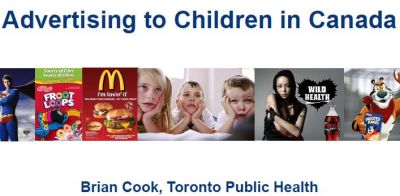 Food companies spend billions of dollars a year to advertise their products. Some of that marketing is targeted towards children, even if the foods advertised aren’t necessarily part of what health-care professionals call a balanced diet. This week on Food Matters, I looked at one of the first studies to link advertising to childhood obesity.
Food companies spend billions of dollars a year to advertise their products. Some of that marketing is targeted towards children, even if the foods advertised aren’t necessarily part of what health-care professionals call a balanced diet. This week on Food Matters, I looked at one of the first studies to link advertising to childhood obesity.
The study was done right here in British Columbia at UBC, along with some help from the University of Illinois, but it was looking specifically at the province of Quebec. Why Quebec? Well, way back in 1980 the provincial government brought in legislation that was the world’s first advertising ban of fast food. This was a ban of ads in print and electronic media targeted toward children of fast food and any toys associated with fast food. The study compared purchases of fast food by similar families in Ontario, and also obesity rates in children. Some numbers from the study are quite startling…
 Tirtha Dhar
Tirtha Dhar
Assistant Professor Tirtha Dhar, a marketing expert at UBC’s Sauder School of Business says that the ban on advertising effectively reduced fast food consumption in households by as much as 13 per cent each week, and that even though Quebec children have one of the most sedentary lifestyles, they have one of the lowest childhood obesity rates in Canada.
In North America right now every two out of ten children are obese. A lot of that obesity is blamed on the consumption of fast food, junk food, and child health activists believe that these kinds of foods shouldn’t be marketed to children because the ads lead to greater consumption of those foods and that those ads should be banned. The product manufacturers don’t like being told they can’t market their products to a particularly malleable part of the population and always claimed there’s no link to obesity because of the ads, but the authors of this study claim that this is the first proof that the link exists in fairly black and white results based on a ban of advertising that’s been in effect for the past 32 years. Other data that was out there on this was from relatively small-sized surveys that gave more of a snapshot in time as opposed to this one where there was a wealth of information available from over three decades of census and health data.
To be fair, some changes started to be made voluntarily by Kellogg’s Canada, for example, about four or five years ago. They stopped marketing certain breakfast cereals to children that didn’t meet a set of nutritional guidelines they established, and they started to change the packaging on the cereal boxes to make it easier for parents to figure out what they were getting in the package. That doesn’t mean they actually changed what was in the boxes, just changed the packaging and marketing.
Marketers have always realized that children were a good target for some of their products. I went to a seminar a few years ago on this very topic and was quite impressed with a presentation from Brian Cook, a researcher with the Toronto Board of Health. He said that if there wasn’t a clear link between the power of advertising and how it affected children a lot of marketing executives would have been fired for spending millions of dollars on those ads targeted toward children. If it wasn’t working, they wouldn’t have kept doing it, right?
What has changed over the past few years is that there are so many more ways of reaching children these days. Toys connected with food have been out there for a long time, but now beyond toys and television, there are ringtones for kids who have cellphones, and there are lots of those, celebrity endorsement, contests, online games, websites with online games and of course social networking websites like Twitter and Facebook, where incentives are often offered if you ‘spread the word’.
 Michele Simon
Michele Simon
By and large food and beverage advertising in Canada is unregulated, or self-regulated by the industry, except in Quebec. Michele Simon is a public health lawyer who has been researching and writing about the food industry and food politics since 1996. She thinks that the processed food industry is not doing enough to curb marketing toward children and tries to place too much of the blame for overconsumption of junk food on parents. Simon would like to see more governments enact legislation that would end the use of cartoon characters, toys and websites targeted toward kids by processed food advertisers, along with other electronic methods.
And what about parents, what role should they play in what advertising their children are exposed to and what they end up eating? That’s a tough question. Kids are exposed to so much marketing these days and advertisers want to build brand loyalty when they’re young as a loyal customer can represent so much to a company over their lifetime. You can’t expect to raise your kids in a bubble, either. So somehow you have to strike a balance, try to educate them about the foods they eat and be careful about how you shop.
If you would like to listen to my chat with Jo-Ann Roberts on All Points West on this subject, just click here.



